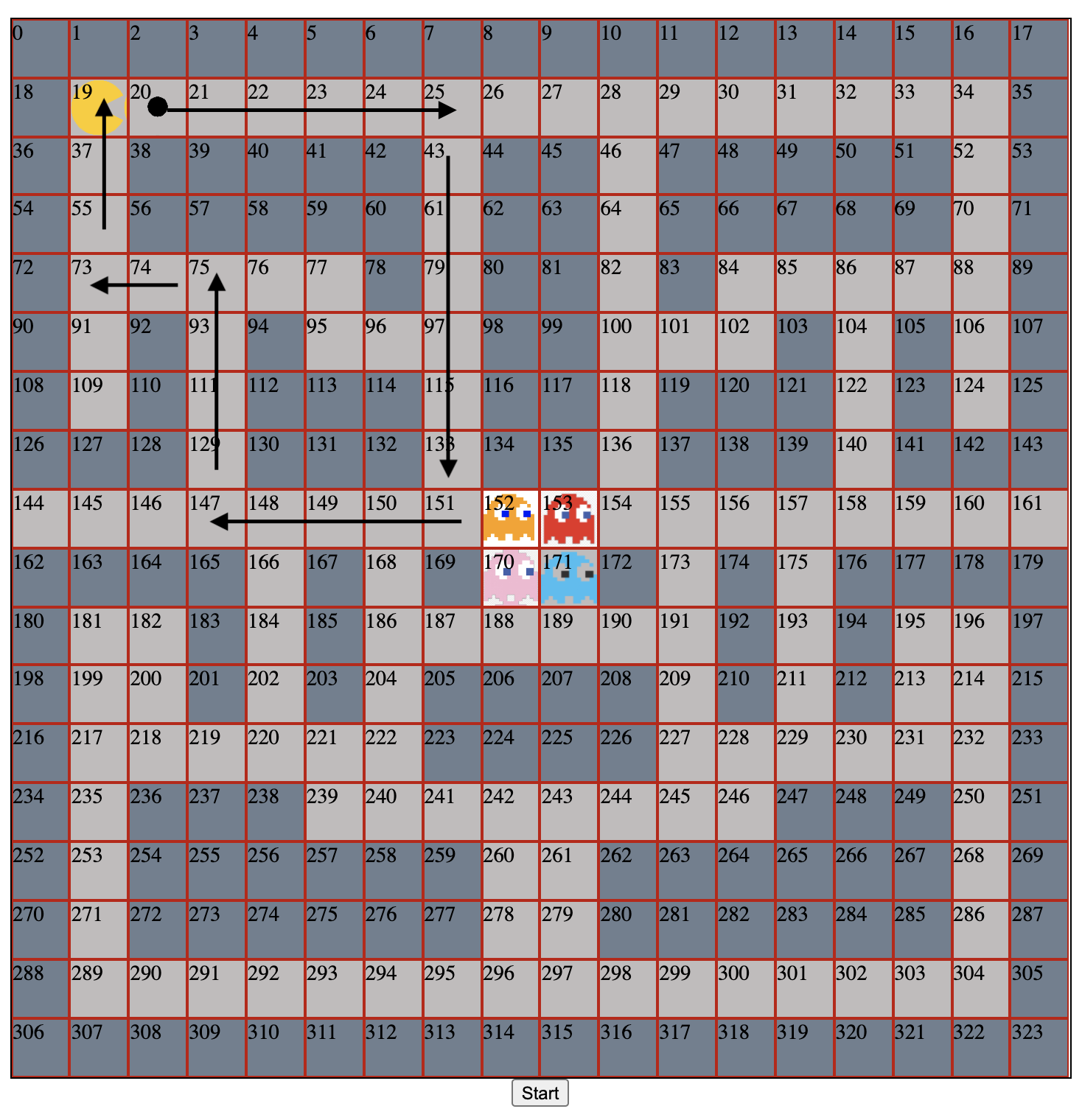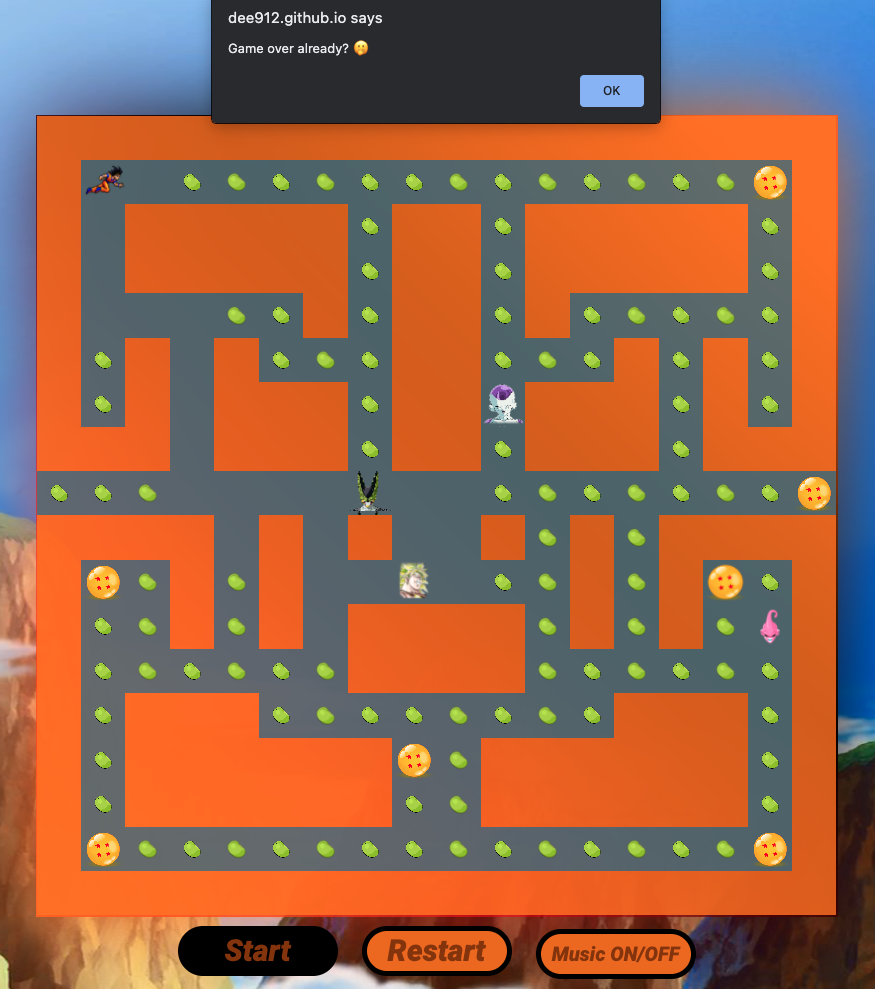PAC-MAN with added flair
Overview
The project here is my first during the Software Engineering Immersive course at GA and my first coding project in general. This assignment was to build a grid-based game using HTML, CSS and JavaScript. It was an individual project completed within one week.
My cohorts and I were given a selection of games to choose from so I decided on the classical and personal favourite, PAC-MAN. I created a rendition of the game in a Dragon Ball Z theme. I will be referring to characters as in the original game as this is easier to understand.
You can launch the game directly from here!
Brief
- Render a game in the browser.
- Design logic for winning.
- Include separate HTML / CSS / JavaScript files.
- Follow KISS (Keep It Simple Stupid).
- Use JavaScript for DOM manipulation.
- Deploy your game online, where the rest of the world can access it.
- Use semantic markup for HTML and CSS (adhere to best practices).
Technology used
- HTML
- CSS
- JavaScript
- Git and GitHub
- Google Fonts
- Image editor
Approach
Grid set-up
-
For the grid I set a const variable for the width I wanted and then used a for loop to push the newly created divs into an empty array representing the cells.
- I used this method as it allowed me to freely play around with the size of my grid and decided on what was right for me.
const width = 18 const cells = [] for (let i = 0; i < width ** 2; i++) { const div = document.createElement('div') grid.appendChild(div) div.innerHTML = i div.style.width = `${100 / width}%` div.style.height = `${100 / width}%` cells.push(div) }
-
Elements such as the wall, path and food were also represented by hard coded array and classes added using a
forEacharray method, in hindsight this would be my approach now which will be discussed further down in the Lessons learned/ Alternative approach section.- The reasons for this was due to not foreseeing future issues I would run into and thinking it to be the fastest way.
movable.forEach(walk => {
cells[walk].classList.add('path')
})
food.forEach(item => {
cells[item].classList.add('food')
})
dragonBalls.forEach(ball => {
cells[ball].classList.add('dragonballs')
})
blocks.forEach(barrier => {
cells[barrier].classList.add('wall')
})- For my PAC-MAN and ghosts I just set their starting positions and then added classes to those cells.
let gokuPos = 19
const ghosts = {
clydePos: 152,
blinkyPos: 153,
pinkyPos: 170,
inkyPos: 171,
}
cells[gokuPos].classList.add('pacman')
cells[ghosts.clydePos].classList.add('clyde')Random movements
- For my random movements I decided to place all possible movements into an array and access that array using a random number each time a ghost hit a wall element.
- I went for this approach as it kept my logic pretty simple and it was easy to apply to all ghosts after testing on Clyde.
setInterval(() => {
let clydeMove = null
while (!clydeMove) {
clydeMove = ghostDirection[Math.floor(Math.random() * ghostDirection.length)]
console.log(clydeMove)
}
if (movable.includes(ghosts.clydePos + clydeMove)) {
cells[ghosts.clydePos].classList.remove('clyde')
ghosts.clydePos += clydeMove
cells[ghosts.clydePos].classList.add('clyde')
pacManReset()
}, 300)Collision detection
- Collision detection for PAC-MAN went through a few stages, first all the border walls were avoided using a calculation but I soon realised that once I add in my internal walls the maths functions wouldn't be of any use to them.
- This is where the idea of setting the moveable and blocks arrays above came from. Once they had been set I was able to just plug it into my keydown event listener.
document.addEventListener('keydown', (e) => {
livesLeft.innerHTML = lives
//pacman controls
const key = e.key
if (key === 's' && movable.includes(gokuPos + width)) {
cells[gokuPos].classList.remove('pacman')
gokuPos += width
cells[gokuPos].classList.add('pacman')
}- For the tunnel I hit another bug which was when PAC-MAN walked through the tunnel on either end he would end up stuck in the wall on the opposite side or he wouldn't walk through at all.
- So to resolve this I made it possible for PAC-MAN to move even though the next block would be a wall and then just reset his position immediately, this made for a smooth transition that looked as though he was just walking through.
//tunnel at centre of the map
if (gokuPos === 162) {
cells[gokuPos].classList.remove('pacman')
gokuPos = 144
cels[gokuPos].classList.add('pacman')
} else if (gokuPos === 143) {
cells[gokuPos].classList.remove('pacman')
gokuPos = 161
cells[gokuPos].classList.add('pacman')
}Power up/ Dragon Balls
- As time was a little short once I got to the power ups I went for an efficient quick way of making them work however not the most condensed way.
- I went for this approach as I still wanted the function to work but also needed to improve other persistent issues.
dragonBalls.forEach(item => {
if (gokuPos === item) {
cells[item].classList.remove('dragonballs')
score += 5
}
}) function cellReset() {
if (gokuPos === ghosts.clydePos) {
cells[ghosts.clydePos].classList.remove('clyde')
ghosts.clydePos = 152
score += 10
cells[ghosts.clydePos].classList.add('clyde')
}
}- Once I wrote the above function I just called them in the below setInterval. This kept it looking more neat compared to my setInterval for my ghosts movement which is cluttered.
- After PAC-MAN ate one of the power ups there will be a 10s period where the ghosts can be eaten and the score increased by 10 pts.
setInterval(() => {
if (dragonBalls.includes(gokuPos)) {
cellReset()
freezaReset()
buuReset()
brolyReset()
}
}, 10000)Screenshots
Before getting the idea of how to move my ghost randomly I was going to hard code in a path, I was setting the movements here in an array which then sparked the idea for how I got my ghosts to move.
Splash screen
Start screen
Win screen
Lose screen
Bugs
With this being my first project I was surprised by how bugs came about and even as I may blame the code it was always due to minor human errors.
Score bug:
- At present my score will increase simply from keying down.
- After thinking about it I understand it is because I hard coded my food path so even if there is no food class since the cell is called food the game will always recognise keying down on those cells means a score increase.
- Also my end game functions are not as well written as I would have liked it to be and instead kicks off an alert saying the player has won at a score of 176 as this was the amount of food cells I had at the time of writing it.
Lives bug:
- Currently my life display up top only begins to display the live available after the first keydown.
- I realise in hindsight that is due to calling the Lives.innerHTML in the keydown event listener.
Wins and challenges
Wins
- Getting my ghosts to move randomly was a big achievement for myself.
- The overall style of the project.
Challenges
- Getting the ghost to move randomly was a challenge for a couple of days.
- Border detection was an issue, the ghost would be able to move one square into them and then be stuc, since fixed.
Lessons learned/ Alternative approaches
Map setup
- For the map I would look into instead of hardcoding in each style of path, moveable, food etc., to instead set up the map with an assigned number.
- A barrier/wall would be labeled 1, food would be labeled 2 which wouldn't clash with the block and dragon balls would be labeled 3.
- Labeling them this was in an array would then allow me to wrap them to form the grid.
Assistance
- Asking for help was a big learning curve, it's rather easy to get caught up in your own issue and forget there are Teachers and TAs around to help where needed.
- By welcoming help more often I know I could have turned out a much better product and will ask for help where needed in the future.
Potential future features
- New level once the current level has been completed.
- Smart moving ghosts depending on PAC-MAN's position.
- A working scoreboard.
- Leaderboard included.
References
Very grateful for the following resources:
Characters
- Goku: https://bit.ly/3hjJr1w
- Cell: https://bit.ly/3uJTqRq
- Freeza: https://bit.ly/3vVNd56
- Buu: https://bit.ly/3tEyoCj
- Broly: https://bit.ly/3fccWiN
Food
- Soy bean: https://bit.ly/2Q7zLvC
- Dragon Ball: https://bit.ly/33CQ0nw
Theme
- Main background: https://bit.ly/3tEa5Vc
- Heart: https://bit.ly/2SxTy8j




